125 Physics Projects for the Evil Genius (52 page)
Read 125 Physics Projects for the Evil Genius Online
Authors: Jerry Silver

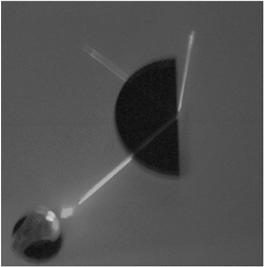
Figure 87-1
Incident light is refracted and reflected
.
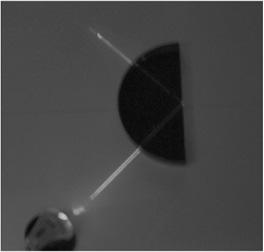
Figure 87-2
Total internal reflection of incident light
.
When light enters a material where it goes faster, the angle approaches 90 degrees as the incident angle increases. Because the angle of refraction cannot be greater than 90 degrees, light above the critical angle is totally reflected.
Variable index of refraction. (Based on a lecture demonstration posted at the UCB web site:
www.mip.berkeley.edu/physics/E+60+40.html
.)
Refraction takes place when light goes from one material to another. Fiber-optic cable and other optical devices take advantage of a variable index of refraction to guide the light in a channel. To do this:
- Cover the bottom of an empty fish tank evenly with about 1 cm (about ½ inch) of granular sugar.
- Add water to the tank as slowly and carefully as you can, so you disturb the layer of the sugar as little as possible. Warm water at about 70 degrees C will enable the sugar to dissolve more quickly.
- Fill the tank with a few inches or so of water.
- Let the tank remain undisturbed for a few days, allowing the sugar to slowly dissolve. The concentration of the sugar solution—and, as a result, the index of refraction—will vary with the height above the bottom of the tank.
- Darken the room.
- Direct a laser from the side of the tank at an angle with respect to the bottom of the tank. The beam should be guided, as if through an invisible light pipe in the tank. This use of a variable index of refraction is similar to the way a fiber-optic cable guides a light beam. If the laser is directed at an angle, the light may go through several bounces if the tank is long enough and the distribution of the sugar is uniform. This also illustrates how mirages form. When light passes through cooler air to warmer air over a road surface, the variable index of refraction guides the light in a way that creates the illusion of water lying on the road.
Optical fibers can be found in toy and novelty stores, and as a part of certain lamps. These work on the principle of total internal reflection and they show how light can be “piped” around corners. A similar way to explore this is to shine a laser into an acrylic cylinder. Although a good bit of scattering is within the acrylic, the light is trapped inside in a similar manner to an optical fiber, as shown in
Figure 87-3
.
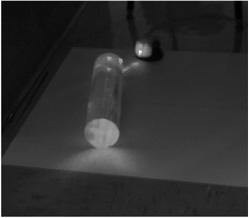
Figure 87-3
Light coming in one side of the tube is trapped by total internal reflection and emerges from the other side
.
If the angle that a light ray strikes a surface is too large, the light will not pass through to the other medium. This can only happen if the speed of light is faster in the second medium (or if the index of refraction in the second medium is smaller). For angles greater than that critical angle, no light is refracted, but is instead totally reflected back into the material from which it originated.
The disappearing beaker
.
This demonstration lets you set up a cloaking shield that makes a glass object disappear.
- Pyrex beaker
- other glass objects such as Pyrex stirring rods and magnifying glasses
- transparent container large enough to hold the beaker
- cooking oil (such as Wesson, baby oil, Karo syrup, or light and heavy mineral oil)
- Place the beaker in the larger container.
- Fill the container with the oil.
- Immerse the beaker in the oil and slowly pour the oil into the beaker.
- Observe what happens when other glass objects are placed in the oil (
Figure 88-1
).
As the oil level rises above the beaker, the glass can no longer be seen. If any markings are on the side of the beaker, they will still be noticeable, as seen in
Figure 88-2
.
If you use other liquids, similar results may be obtained, but you may have to do some fine tuning. Other types of glass and other oils (including the “lite” version of cooking oils) may be less perfect, leaving some ghost images that are less noticeable the farther away your “audience” is. A mixture of a heavy and light mineral oil (in a ratio of about 2:1 to start) should match Pyrex and be adjustable for other types of glass. Karo syrup is a close match to Pyrex and can be diluted with water to match other types of glass.
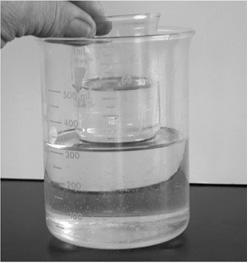
Figure 88-1
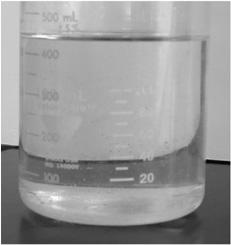
Figure 88-2
Disappearing beaker
.
The magnifying glass will not enlarge images when submerged.
The precise index of refraction for these materials may vary slightly with temperature. Also, imperfections in the glass may make it difficult to make the very last trace disappear on some samples.
Objects are visible to the extent that they are able to reflect light. If an object immersed in a liquid has an index of refraction that is different than the object, some of the light is refracted through the object and some is reflected back to the observer. However, if the object has exactly the same index of refraction as the immersed object, the light will neither reflect nor refract at the interface between the object and the liquid it is immersed in. In that case, the object will appear to be invisible.
Lenses, such as magnifying glasses, work by virtue of their index of refraction being
different
than the index of the medium around it. If the index of refraction surrounding the lens is increased from 1.0, which is the index of refraction of air, to an index very close to glass, the light rays will
not
be bent through a focal point and magnification will not occur.
Both Wesson cooking oil and Pyrex glass have a nearly identical index of refraction of about n = 1.474, making them particularly well matched for this demonstration.
A similar experiment along these lines is first to pour a water-alcohol mixture to a beaker, and then cover it with cooking oil. If a small enough amount of alcohol is in the mixture (less than twice as much oil as water), the oil will float and it will also not mix with the alcohol-water layer. If you add a few drops of food coloring to the water-alcohol mixture, the effect is easier to see. Viewing from the top, the water-alcohol layer is invisible. This is the result of total internal reflection at the interface between the layers.
Transparent objects are visible because of reflection from their surface. Transparent objects will partially reflect and partially refract light if there is a difference between their index of refraction and that of their surroundings. If the index of the material and their surroundings is the same, the object will appear to be invisible.
Hot and Cold
How much heat is needed to melt Greenland? Heat of fusion
.
Ice anywhere requires a certain specific amount of heat to melt. Ice melts at 0°C. Once at that
temperature
, the amount of
heat
needed depends only on how much ice you have. Heat can either change the temperature of something or cause it to change from one state to another. In this experiment, that change is from solid to liquid. You will determine how much heat is needed to melt a given mass of ice by carefully keeping track of temperature changes and heat flows.
- Styrofoam cup
- cube of ice
- graduated cylinder (250 mL)
- water
- thermometer
- stirring rod
- scale
- Fill the beaker with exactly 150 mL of water at a temperature of at least 25 degrees centigrade. This results in a mass of the water, m
w
, of 150 g. - Remove an ice cube from the freezer and let it sit out until it just begins to melt. This establishes its temperature at (very close to) 0 degrees centigrade.
- Measure the mass of the ice cube, m
ice
, in grams. If significant melting has occurred, you can use a paper towel to absorb any excess liquid water before measuring the mass. - Measure the initial temperature of the water, T
i
, before the ice cube is added. - Drop in the ice cube. Stir gently. Measure the final temperature, T
f
, as soon as the ice cube has completely melted. - Calculate how much heat was needed to melt the ice through the following steps (see
Figure 89-1
):